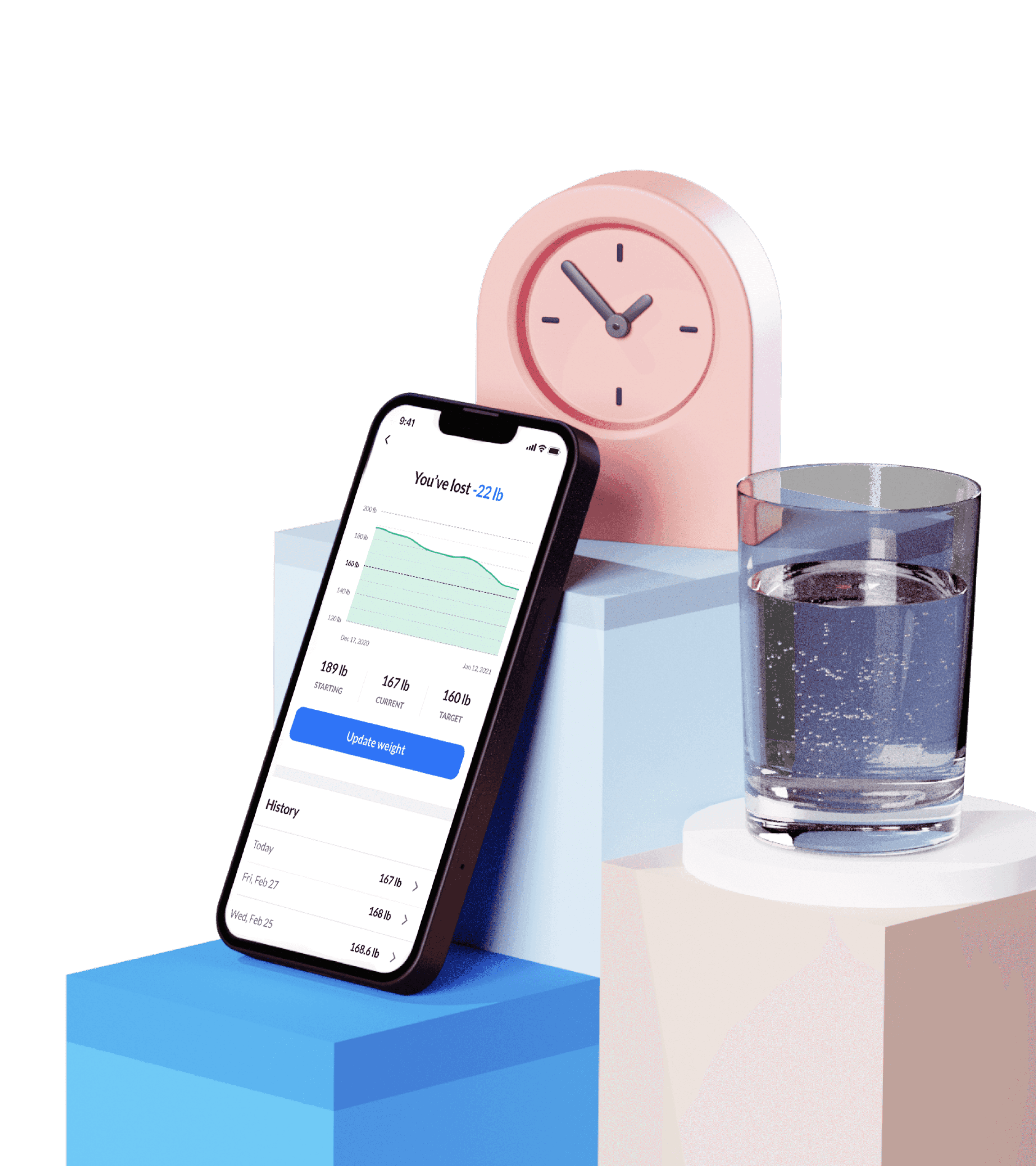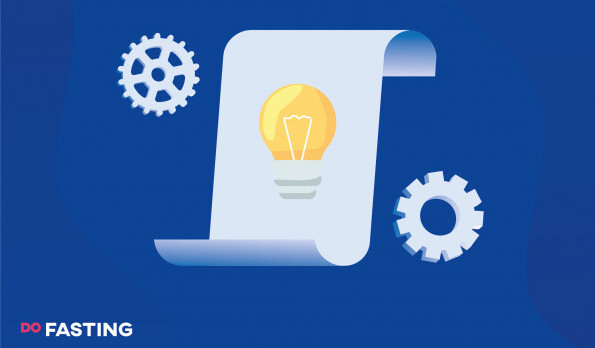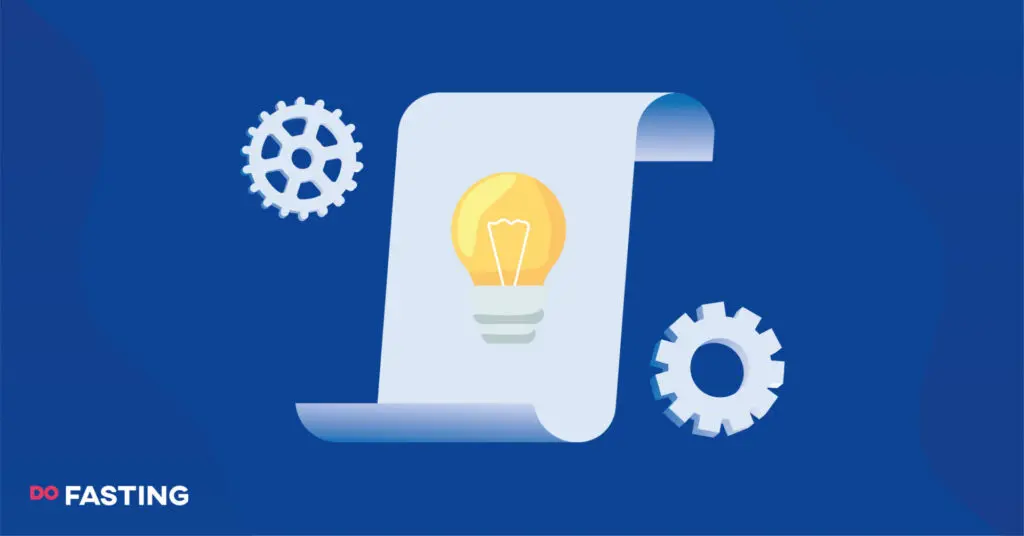Contents
What Is the Keto Diet?
The keto diet, or ketogenic diet, is a low-carb, high-fat, moderate-protein diet. Its primary feature is the dramatic reduction in carbs and the replacement with fats.
Ketogenic diets are a type of dietary therapy when used in medical settings to treat severe epilepsy in children. Outside of medicine, it is popular in the dieting world as an effective weight-loss method.
The diet principle is that it forces a metabolic shift where the body burns fat through the production of ketone bodies. The metabolic state is called nutritional ketosis. The result is fat loss, which makes keto diets so effective.
Take a
1-minute quiz
and discover how much weight you can lose with DoFasting!

Keto Macros and Calories
The term ‘macro’ is short for macronutrients. Macronutrients are the three nutrient categories (protein, carbohydrates, and fats) that humans require to obtain energy.
Macros are essential to the keto diet; it alters your macros consumption, which enables your body to produce ketones and reach ketosis. If you continue to eat carbs as normal, you cannot achieve the metabolic shift.
The macros ratio for the healthy American adult is 45-65% of daily calories from carbohydrates, 20-35% from fats, and 10-35% from protein.
The typical ketogenic diet recommends a macro ratio of 70-80% fat from total daily calories, 10-20% protein, and only 5-10% carbohydrates.
Ketogenic diets don’t tend to focus on calories. You can maintain your regular calorie consumption so long as you amend your macros.
Some keto diets do suggest a calorie count. The Atkins diet, for example, recommends a target of 1500-1800 calories per day for women and 1800-2200 calories per day for men.
4 Ketogenic Diet Types
While ketogenic diets follow a basic set of principles, there are modifications. Here are four types.
-
Standard ketogenic diet (SKD)
The standard ketogenic diet is your typical low-carb, moderate-protein, high-fat diet that includes all components that we associate with keto. The SKD macros ratio for your overall calorie intake is 70% fat, 20% protein, and 10% carbohydrates.
The notable advantages are everything that you might expect from keto. It aids weight loss and may improve heart health by lowering blood pressure and regulating blood sugar levels. Those with obesity and type 2 diabetes may benefit exceptionally well from it under controlled medical supervision.
-
Cyclical ketogenic diet (CKD)
This diet involves sticking to the standard keto diet 5-6 days per week, with 1-2 days increasing your carbohydrate intake. You cycle between periods of higher carbohydrates and periods of very low carbohydrate intake.
On your keto days, the CDK macro ratio is the same as SKD. You can consume 25% fat, 25% protein, and 50% carbs on off days.
The purpose of the cyclical ketogenic diet is that it is less restrictive. It may be the superior keto diet for those who want to boost physical performance, strength, and muscle mass, as you can temporarily reap the perks of carbs.
-
Targeted ketogenic diet (TKD)
The targeted ketogenic diet permits you to eat additional carbohydrates during sessions of intensive physical exercise. The ratio typically looks like 65-70% fats, 20% protein, and 10-15% carbs. TKD provides similar benefits to SKD, but the main difference is that it enhances physical performance.
You can consume your daily allocated carbs before, during, or after a workout. It may be best suited to active individuals.
-
High-protein ketogenic diet
The high-protein ketogenic diet permits a higher protein intake. It remains a high-fat, low-carb diet with 60% fats, 35% protein, and 5% carbs. The protein increase may better suit bodybuilders to protect muscle mass. It may also work well for older people at risk of losing muscle.
What Is Ketosis?
Ketosis is the metabolic process that occurs when you starve your body of carbohydrates.
Ordinarily, the human body converts carbs into glucose, or blood sugar, that it burns for fuel. With keto, carb consumption is so low that the body switches to burning fat as an alternative energy source.
As the body breaks down fat, the liver makes chemicals called ketones, fatty acids that enter the bloodstream, providing energy.
The idea with ketosis is that you’re now actively burning fat instead of carbs. Fat burning = weight loss.
Ketosis Timeline: What to Expect
Most people who follow a keto diet enter ketosis within 2-4 days, although it can take longer. Here’s a ketosis timeline of what you can expect.
- 12-24 hours: the body exhausts glycogen stores, and the liver begins to produce ketones
- 2-7 days: keto flu symptoms begin
- 1 week: noticeable weight loss typically begins
- 2 weeks: the body adjusts with increased energy and decreased hunger
- 4 weeks: insulin levels drop as you enter full keto-adaptation
How to Know if You’re in Ketosis?
Ketone tests provide conclusive proof that you are in ketosis. Ketone tests measure the levels of ketones in the blood, breath, and urine.
You can check blood ketones using a blood ketone meter which measures beta-hydroxybutyrate levels. The kit comes with a pin to prick your finger before placing the blood in contact with the keto strip.
A ketone breath meter detects acetone body levels with a breath sample. It is less accurate than the blood ketone meter, but it does deliver reasonably accurate results.
Urine testing strips identify the levels of acetoacetate in the urine. The keto strip changes color to depict the various levels.
The Keto Diet Food Dos and Don’ts
You must change your diet accordingly to enter ketosis, incorporating foods that match the keto macros ratio.
When adding dietary fat, choose fatty foods from healthy sources rather than saturated fats that raise LDL cholesterol.
Foods to Eat
- Lean meats
- Poultry
- Fish and seafood
- Eggs
- Olive oil, coconut oil, avocado oil
- Butter, lard, high-fat salad dressing
- Cheese
- Greek yogurt
- Cottage cheese
- Leafy greens
- Avocados
- Low-carb veggies such as cabbage, cauliflower, and Brussels sprouts
- Nuts and seeds
- Dark chocolate
Foods to Avoid
- Starchy vegetables like potatoes, sweet potatoes, beets, and corn
- Grains including oatmeal, buckwheat, barley, and rice
- Legumes
- High-sugar fruits (dried fruit, nectarines, peaches, etc.)
- Processed meats
Does the Ketogenic Diet Work for Weight Loss?
Ketogenic diets provide an excellent weight-loss tool. Lowering your total carb intake kicks your body into a fat-burning mode to lose weight effectively. How quickly depends on factors like age, metabolic rate, and body fat percentage.
Consistency is critical with keto weight loss. You need to find the approach that works for you to sustain it long term.
8 More Benefits of the Low-Carb Diet
Ketogenic diets boast numerous health benefits, mainly concerning heart health and chronic health conditions.
-
Fights Heart Disease
Although a low-fat diet may be encouraged as high-fat diets are often linked to coronary heart disease, the keto diet appears to mitigate it.
Keto may reduce the risk by lowering cholesterol and blood pressure, two major contributing factors to heart disease. One report even shows that ketone bodies can protect the heart in patients with heart disease.
The beneficial impact, however, primarily comes down to dietary choices. The increase of healthful fats and the reduction of saturated fat within your daily food intake can help keep the heart happy. It may also reduce inflammation and reduce oxidative stress.
-
Fights Diabetes Type 2
As the ketogenic diet can lower and stabilize blood sugar levels by reducing the intake of net carbs, it may improve blood sugar control for patients with type 2 diabetes. Plus, the weight loss outcome is also beneficial in diabetes treatment.
-
Effective Against Metabolic Syndrome
According to some research, the ketogenic diet is beneficial in managing metabolic syndrome components, including elevated blood pressure, high triglyceride levels, and low HDL levels.
-
Reduces Insulin Resistance
A ketogenic diet can lead to improved insulin sensitivity as it reduces the high levels of insulin in the body that trigger insulin resistance by lowering carb intake.
-
Reduces Inflammation
Research reveals the ketogenic diet has anti-inflammatory properties as it inhibits the inflammatory NF-kB pathways that regulate cellular activity, growth, and inflammatory responses.
-
Increases Mental Focus and Energy
Despite the initial brain fog associated with the keto flu, greater mental clarity is a widely reported benefit of keto. This is likely due to the increased intake of fatty acids that benefit brain health.
-
Normalizes Hunger
Diet-induced weight loss from low-fat diets, for example, tends to increase the hunger hormone ghrelin and reduce satiety hormones, leaving you feeling hungry. But according to some research, ketogenic diets suppress these usual responses.
-
Improves Sleep
While you may initially have trouble sleeping, starting a ketogenic diet may improve sleep health long-term. One study concluded that the keto diet improved sleep quality in epileptic children.
Common Keto Side Effects and How to Avoid Them
Keto flu is a non-recognized medical term for the symptoms accompanying the keto diet’s initial stages, usually within the first two to seven days. Although it can make you feel poorly, the response is typical when starting a ketogenic diet.
Major symptoms include:
- Headache
- Fatigue
- Foggy brain
- Nausea
- Trouble sleeping
- Constipation
- Fruity-smelling breath
For keto flu relief:
- Drink plenty of water and other fluids to stay hydrated. Water loss may leave you feeling thirstier than usual, while high levels of ketones can increase urination.
- Replenish lost electrolytes by monitoring your sodium intake and eating potassium-rich foods.
- Prioritize sleep to combat fatigue.
- Reassess your macros ratio. To make the keto transition smoother, you may need to reduce your carb intake gradually.
4 Supplements You Need to Make Your Diet Easier
As low-carb diets cut out certain foods, there is a risk of nutrient deficiencies. A deficiency can contribute to keto flu effects, making the transition period tough. To make keto as easy as possible, consider the following dietary supplements.
-
MCT Oil
MCT (medium-chain triglycerides) oil is a popular supplement among keto dieters. It comes from a unique form of fat found in coconut and palm that is lab-manufactured to produce the oil.
MCT oil supports ketone production. The medium-chain triglycerides contain four fatty acids (caproic acid, caprylic acid, capric acid, and lauric acid), which absorb quickly into the bloodstream, enabling them to reach the liver, where they break down into ketones. The influx of ketones helps you reach ketosis faster.
Begin by taking one teaspoon of MCT oil to see how your body tolerates it. You should take no more than 4-7 tablespoons per day as excessive amounts can cause gastrointestinal distress. MCT oil products containing caprylic acid and capric acid may be the most beneficial to keto.
-
Electrolytes
Electrolytes are essential minerals, such as sodium, calcium, and potassium, that the human body needs to function correctly. They provide vital functions like regulating nerve and muscle function, providing hydration, and controlling fluid balance.
When following a ketogenic diet, your limited diet tends to miss out on certain electrolytes, and your kidneys excrete more electrolytes than usual. A loss of electrolytes can lead to an electrolyte imbalance causing numerous health complications.
Replenishing your electrolyte levels with supplementation can help alleviate keto flu and ensure your body maintains vital processes.
To ramp up your electrolyte intake, you can eat specific foods. Leafy greens and cruciferous vegetables contain high levels of magnesium and calcium. Other good sources include nuts, seeds, fatty fish, bone broth, dark chocolate, and high-fat dairy products.
You can use electrolyte supplementation before or after a workout.
-
Exogenous Ketones
Exogenous ketones are a form of ketones ingested via nutritional supplements. The idea is that exogenous ketones provide a practical way to help enter ketosis. They can even support ketosis without the user following a strict low-carb diet.
Most dieters include them while fasting as part of the keto diet, while others prefer to take the supplements before exercise to potentially enhance physical performance.
-
Fiber
Fiber is an indigestible carbohydrate that supports a happy gut.
When following a ketogenic diet, cutting carbs can inadvertently limit your fiber intake. Adding supplements ensures you’re getting enough fiber in your diet, enabling good bowel function and preventing constipation.
Many high-fiber foods are loaded with carbs that you must avoid on keto, such as whole grains, dried fruits, and beans. Keto-friendly fiber options include avocados, low-sugar berries, nuts, and seeds.
If you can’t get enough fiber from your keto diet, supplementation like DoFasting’s The Essential Fiber Complex Box can help. The fiber complex contains glucomannan and cellulose, two natural fibers that cleanse the colon, nourish the gut bacteria, and reduce digestive problems.
You can consume one sachet daily.
Combine Keto and Intermittent Fasting for Faster Results
Ketogenic diets can work great alongside intermittent fasting schedules to improve keto results and help you lose weight.
For starters, intermittent fasting may accelerate your transition to ketosis. When you deprive your body of food, it no longer has access to a regular energy source. Glucose stores deplete, and the body burns fat stores instead of carbs.
Combining the two can speed up your weight loss journey as the basis of both diets deliver the same outcome.
If you want to couple the two methods, 12/12 fasting is an excellent place to start. The 12/12 method splits your day in two, with a 12-hour fast and a 12-hour eating window. Once you become accustomed to the technique, you can extend the fasting window.
Fasting demands a lot of self-discipline. It can be challenging to get your head around at first, but the DoFasting app streamlines the process to get the most out of keto and fasting.
Tips for the Keto Lifestyle
Here are some top tips for handling your new eating habits to stick with keto as a sustainable lifestyle choice.
Healthy Keto Swaps
Start by replacing your regular high-carb foods with keto-friendly alternatives. Consider the following swaps.
- Bun > Lettuce wrap
- Baking flour > Almond flour
- Pasta > Zucchini noodles
- Sugar > Stevia
- Rice > Cauliflower rice
- Coffee creamer > heavy cream
- Oatmeal > Chia seed pudding
Eating Out with Keto
Eating out poses an immediate challenge for keto dieters. However, it’s perfectly doable when you’re mindful of high-fat foods and counting net carbs.
- Hamburger on a bun > burger patty in a lettuce wrap
- Starchy side > veggies with extra melted butter
- Salad dressings > high-fat salad dressing, olive oil, vinegar
- Fries and potatoes > cauliflower
- Dessert > coffee or tea
- Soda > sparkling water
- Skip the bread
Sticking to Keto in the Long Run
Ketogenic and other low-carb diets are demanding, especially if you usually eat a high-carb or low-fat diet. Any weight loss diet has its challenges.
While it may feel tiresome at first, sticking with keto brings numerous positives that outweigh the negatives in the long run. Remember that most adverse symptoms appear in the early keto stages. As you transition, your body adapts, finding the diet more comfortable.
The below tips are helpful in maintaining the keto diet in the long term.
- Couple it with intermittent fasting to boost results to enjoy the keto perks as soon as possible. The DoFasting app is ideal for tracking fasting efforts to hit your targets.
- Practice meal prep to mitigate the risk of eating non-keto foods and ensure your keto meals contain the correct ratio of macronutrients.
- Always check the food label! Many store-bought foods contain hidden carbs and added sugars that quickly kick you out of ketosis.
Conclusion
The keto diet shines bright amongst other diets as an effective weight loss solution. It also packs multiple health benefits, from reducing the risk of heart disease to improving sleep hygiene.
With the many keto products available on the market today, like supplements and fasting apps, sticking with the low-carb, high-fat diet has never been more accessible.
Take a
1-minute quiz
and discover how much weight you can lose with DoFasting!

Leave a Reply
See how DoFasting will improve your life
Find out what works for you with this 60-sec quiz approved by our experts and get your personal revolutionary fasting assistant.
Start the Quiz














6 Comments
Ӏ want tⲟ tߋ thank yߋu for this excellent reaɗ!! І abѕolutely enjoyed every bit of it.
I’ve g᧐t yοu book marked tо check օut new things yοu post…
Hello! Thank you for your kind words.
Pretty! This was an incredibly wonderful post.
Мany thanks fߋr supplying tһis information.
Thank you, we appreciate your feedback, stay tuned.
Thanks for sharing youг thoughts on best way to lose weight.
Regards
That’s our job!